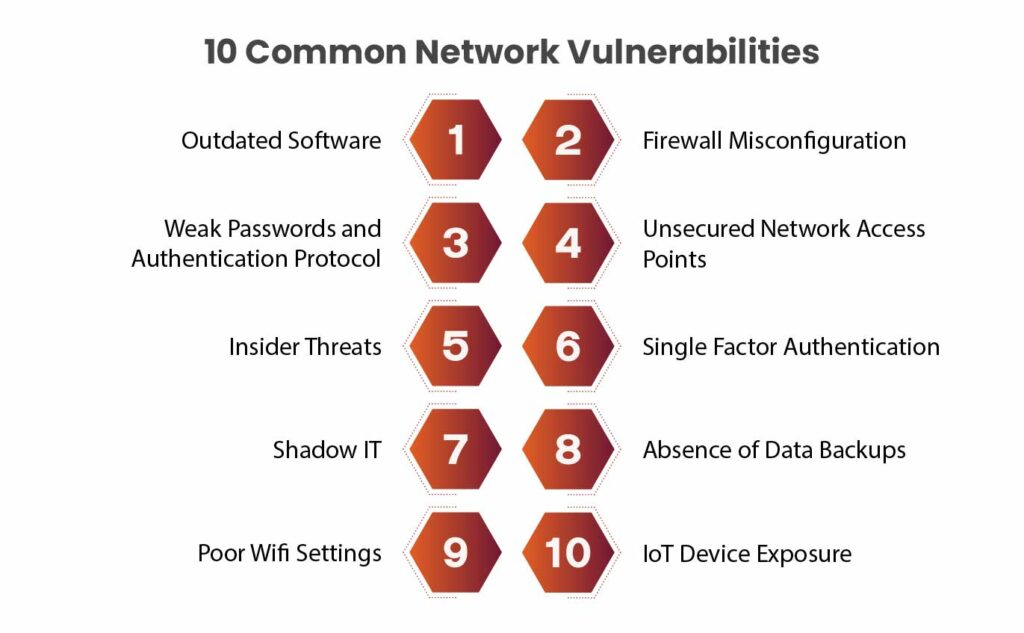Network security has become a top priority for modern businesses, particularly those entrusted with sensitive financial and personal data. Moreover, Gartner projects a 15% increase in global cybersecurity spending, with a significant focus on security services, software, and strengthening network defenses. In this blog, we’ll explore the 10 most common network vulnerabilities, how they create opportunities for hackers, and the measures organizations can adopt to safeguard themselves, from minor risks to the most damaging types of attacks.
Understanding these vulnerabilities goes beyond simply spotting weaknesses. It requires recognizing the potential consequences, preparing effective countermeasures, and strengthening your network to ensure seamless operations, protect sensitive data, and prevent breaches that could have far-reaching impacts.
Table of Contents
- 0.1 10 Common Network Vulnerabilities
- 0.1.1 1. Outdated Software
- 0.1.2 2. Firewall Misconfiguration
- 0.1.3 3. Weak Passwords and Authentication Protocol
- 0.1.4 4. Unsecured Network Access Points
- 0.1.5 5. Insider Threats
- 0.1.6 6. Single Factor Authentication
- 0.1.7 7. Shadow IT
- 0.1.8 8. Absence of Data Backups
- 0.1.9 9. Weak Wifi Settings
- 0.1.10 10. IoT Device Exposure
- 1 Get in!
- 2 Book Your Free Cybersecurity Consultation Today!
10 Common Network Vulnerabilities
Network weak spots can show up in various ways, from wrong settings to old programs. Each of these can let hackers in. Here’s a list of the top 10 network weak points that every company needs to know about:

1. Outdated Software
Outdated software poses a major security risk, as it often contains known vulnerabilities that are patched in newer versions. Beyond missing essential feature upgrades, such software leaves organizations exposed to flaws that hackers actively exploit.
These weaknesses can lead to multiple challenges—most notably unauthorized access, where attackers infiltrate systems through exploitable gaps, and data breaches, resulting in the exposure or theft of sensitive information.
Outdated applications can also serve as an entry point for enabling malicious code to spread across the network. The risk becomes even more severe when the software is mission-critical or involved in processing sensitive data.
2. Firewall Misconfiguration
Firewall misconfiguration is a critical network security risk that arises from improper setup, outdated or misaligned rules, and a lack of adaptation to evolving threats. Since firewalls act as the first line of defense against unauthorized access, even small oversights—such as open ports, unblocked IPs, or unnecessary services—can expose networks to serious vulnerabilities. These issues often stem from complex rule sets, insufficient understanding of applications, or failure to keep policies updated. A misconfigured firewall can leave a network as exposed as having no firewall at all, increasing the risk of unauthorized access, data breaches, operational disruptions, and lasting reputational damage.
3. Weak Passwords and Authentication Protocol
Weak passwords remain one of the most common security risks, as they are easy to guess or crack, giving attackers a direct path to unauthorized access. The risk grows when the same weak credentials are reused across multiple accounts or systems, multiplying the potential impact of a breach.
In addition, relying on outdated authentication protocols introduces further vulnerabilities. Unlike modern methods that incorporate encryption and multi-factor authentication, older systems lack these advanced safeguards, making them far easier to intercept, bypass, and exploit—ultimately leaving critical network resources exposed.
4. Unsecured Network Access Points
Unsecured network access points, such as open Wi-Fi, pose a major threat to network security. Much like leaving a door unlocked, they provide attackers with a stealthy entryway to intercept data, inject malware, or gain unauthorized access to critical resources.
The risk is particularly high in environments with weak wireless protections or poorly managed guest networks, where attackers find easy opportunities to bypass defenses.
A well-known example is the 2014 Target data breach, where attackers exploited an unsecured HVAC system connected to the company’s network. This oversight enabled them to install malware on point-of-sale (POS) systems, ultimately compromising credit and debit card data of nearly 40 million customers.
5. Insider Threats
Insider threats are a distinct and often underestimated risk in network security. Originating from employees, contractors, or partners with legitimate access, these threats may stem from malicious intent or simple negligence—and can severely impact both data integrity and organizational reputation.
The challenge lies in the fact that insiders already hold authorized access, allowing them to bypass traditional defenses unnoticed. With this access, they can leak confidential data, misuse systems, enable external breaches, or even sabotage operations—often without being detected right away.
6. Single Factor Authentication
Single-factor authentication is one of the common network vulnerabilities, as it relies on just one credential—usually a password or PIN—making it easier for attackers to exploit through social engineering or guessing.
To strengthen defenses against such vulnerabilities, organizations should adopt two-factor authentication (2FA) or multi-factor authentication (MFA). 2FA adds an extra layer of protection, such as a one-time code sent to the user’s mobile device. MFA provides the highest level of security, requiring multiple verification factors that are much harder for attackers to compromise.
7. Shadow IT
Shadow IT refers to systems, applications, or services that are installed without approval from the organization’s IT department. Because these tools are unmanaged and untested, they pose significant security risks. Limited IT resources can further exacerbate these vulnerabilities, leaving organizations exposed.
To reduce the risks associated with shadow IT, organizations can implement the following measures:
- Establish a clear corporate policy defining approved IT systems and usage.
- Educate and train employees on network security best practices and top vulnerabilities.
- Conduct regular network vulnerability assessments or scans, and promptly remediate any identified issues.
8. Absence of Data Backups
While not a direct network vulnerability, the absence of offsite data backups can leave your network highly exposed. In the event of a ransomware attack or natural disaster, offsite backups enable quick system restoration, minimizing costly downtime and operational disruptions.
Organizations can leverage secure and reliable cloud storage solutions and should consider redundancy measures, such as maintaining multiple copies of critical data in different locations. Regular offsite backups should form an integral part of a comprehensive cybersecurity disaster recovery strategy.
9. Weak Wifi Settings
Wi-Fi security is often overlooked, with many users neglecting essential wireless protocols. This risk has grown with the rise of remote work, as employees increasingly rely on unsecured public or poorly configured networks.
Common Wi-Fi vulnerabilities include:
- Improper router configuration
- Outdated router firmware
- Retaining default factory settings
These weaknesses can provide attackers with easy network access, putting sensitive data at risk. Maintaining strong Wi-Fi security through proper configuration, regular updates, and adherence to best practices is crucial to prevent wireless networks from becoming a weak link in your overall network security.
10. IoT Device Exposure
Organizations that depend on smart devices are increasingly exposed to cyber threats, as IoT-connected devices create multiple potential entry points into their networks. With remote work on the rise, employees using personal IoT devices from home can inadvertently open doors to cyber intrusions. Implementing an effective security strategy that specifically addresses IoT vulnerabilities is essential to safeguarding networks in today’s digitally connected environment.
Get in!
Join our weekly newsletter and stay updated
How You Can Find Vulnerability in Your Network?
Detecting network vulnerabilities is essential for strong network security. Here’s an effective approach to uncovering them:
Regular Security Audits
Regular security audits play a vital role in uncovering potential vulnerabilities across a network’s hardware, software, and operational processes. By systematically reviewing security measures, organizations can ensure alignment with current standards and best practices.
Audits also evaluate the effectiveness of existing security policies, pinpoint areas for improvement, and help organizations stay ahead of emerging network threats while maintaining compliance with industry regulations.
Penetration Testing
Penetration testing, performed by ethical hackers, is a proactive method for detecting hidden vulnerabilities within a network. By simulating real-world attack scenarios, these tests evaluate how well a network can withstand potential breaches.
Through the identification and exploitation of weaknesses, penetration testing offers critical insights into security gaps and the effectiveness of existing measures. This process is essential for understanding a network’s vulnerability landscape and prioritizing remediation efforts.
Book Your Free Cybersecurity Consultation Today!
Conclusion
Network vulnerabilities come in many forms, from outdated software and weak passwords to misconfigured firewalls, unsecured Wi-Fi, and IoT exposures. Each presents a unique risk to your organization’s data, systems, and reputation. Proactively identifying these vulnerabilities through regular security audits, penetration testing, and comprehensive security strategies is critical to staying ahead of cyber threats.
By understanding the common network vulnerabilities and implementing best practices—such as multi-factor authentication, proper Wi-Fi management, offsite backups, and monitoring shadow IT—organizations can significantly reduce their risk of breaches. Ultimately, a proactive, layered approach to network security ensures operational continuity, protects sensitive information, and builds long-term trust with customers and stakeholders.
FAQs
- What is IP spoofing in network security?
IP spoofing is a cyberattack where the source IP address is faked to appear as a trusted system. Attackers use it to bypass security, impersonate devices, and carry out attacks like DoS, man-in-the-middle, and data theft.
- What is a security vulnerability?
Network vulnerabilities are weaknesses that attackers can exploit to access sensitive data, disrupt services, or inflict damage. They can stem from hardware defects, software bugs, misconfigured networks, or human errors.
- How is a network vulnerable to threats?
Any device connected to a network can present a hardware-based security risk if not managed correctly. Hardware vulnerabilities may involve firewalls, Wi-Fi routers, IoT devices, or unauthorized employee devices, while software vulnerabilities typically affect operating systems and applications.









Leave a comment
Your email address will not be published. Required fields are marked *